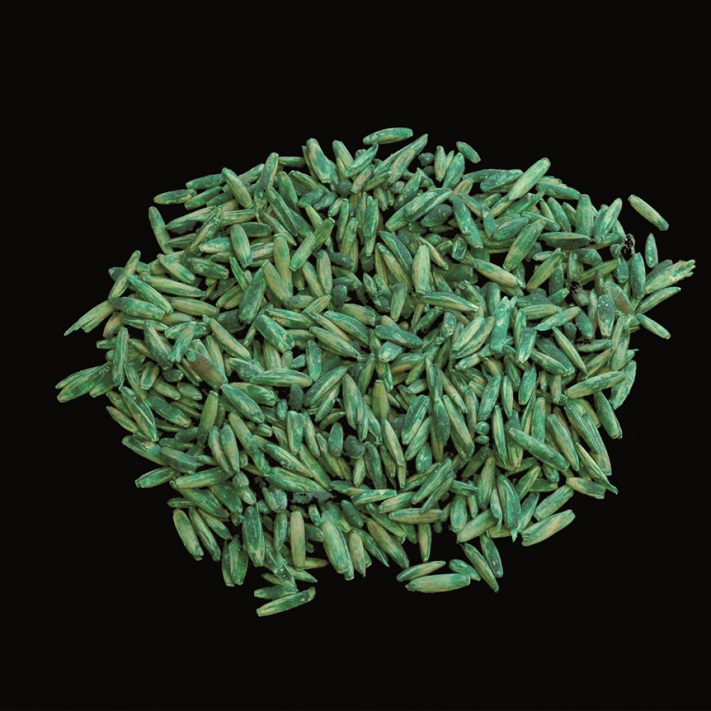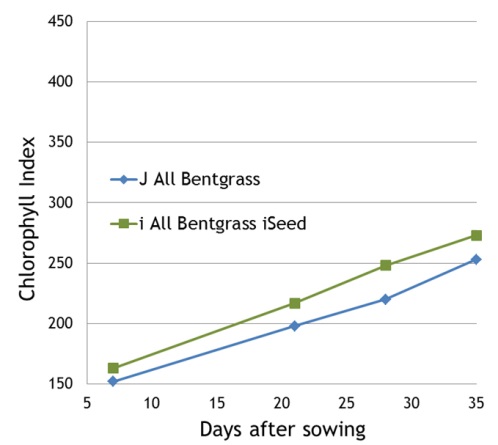iSeed Bent quicker to establish say STRI
Sustainability is currently a buzzword and the more sustainable the sward the better. A key problem that some greenkeepers face is that Poa Annua cannot be maintained sustainably – it has a high demand for water and fertiliser and is prone to disease and thatching up if not cared for adequately. Therefore to increase sustainability, Greenkeepers can increase the proportion of perennial grasses in the sward. Johnsons Sport Seed parent company, DLF Trifolium wanted to determine the effects of oversowing a Bentgrass/annual meadow-grass sward with different Bentgrass seed mixtures. Their belief was that putting new seed into an existing turf bed would see that turf taking nutrient away from the new seed. It followed then that their nutrient coated iSeed would be beneficial during the transition process.
iSeed® is a patented seed coating that focuses on improving nutrient utilisation during the early stages of plant growth. Fertiliser is coated onto the seed meaning the germinating and developing seedling receives the benefit, not the surrounding plant. This is particularly important when overseeding into a competitive sward.

The STRI was selected to carry-out the trial and their ‘Trial Report TP101930’ was completed on behalf of DLF Trifolium in 2012. It was officially notated as ‘The effect of oversowing bentgrass, with or without seed coating, using the Graden Sand Injectior on seedling germination and establishment in managed amenity turf’. This trial aimed to determine any difference in seedling germination and establishment among different bentgrasses, with or without seed coating, following oversowing with the Graden Contour Sand Injector (CSI) in golf-green turf with high organic matter content.
Trial plots were to be sown with [1] Unsown, [2] Manor, [3] Jorvic, [4] J All Bentgrass, [5] Ji All Bentgrass seed coated and [6] J Velvet Bentgrass mix. All plots (50/50 Poa/bent sward with high thatch level) were oversown using the Graden CSI system (remove organic matter, back fill with fresh rootzone and seeds
in one operation) on 3rd July 2012 at approximately 4 g m-2. As iSeed is heavier it was expected that around 50% less iSeed was sown in plots compared to uncoated seed plots.
July was chosen to represent an ideal time to establish new seed and obtain recovery most quickly, but the summer of 2012 was mild and wet. However, due to this mild, wet weather the seed germinated and in-filled the Graden lines in a few weeks with all bentgrass mixtures germinating equally within 20 days from oversowing. Therefore, less optimal germination and establishment conditions were required to elucidate the potential differences among the treatments. By August 2012 the weather conditions were judged to be the best conditions for a second trial. Primo Maxx (400ml ha-1) was applied on 24th August in preparation for this a second oversowing on 31st August trial, again with the Graden CSI.

Establishment within the Graden lines allowed ‘heal-up’ and closing of the lines more quickly in plots oversown with seed coated Ji All Bentgrass - up to 4 weeks earlier compared to non-coated bentgrass seed. This was shown in the subjective Graden line closure assessments and turf quality scores and the objective chlorophyll metre assessments. Therefore, the addition of the seed coating provided extra benefit by decreasing the ‘heal-up’ time post Graden treatment compared to non-seed coated J All Bentgrass. Acceptable turf quality was achieved one month earlier with the seed coated seed and was visibly better than uncoated Bentgrass for a further 5 months. By the end of the trial period all plots showed a similar level of content but confirmed that the iSeed parachuted the new seed into growth much earlier due to its own nutrient.
Throughout the trial, J Velvet Bentgrass did not provide any extra benefit in terms of closure of Graden lines compared to other seed mixes. But at the end of the trial this mixture had significantly higher content of Bentgrass in the sward. In part due to the more invasive habit of this type compared to the other bentgrasses in the trial.
The conclusion of this bent grass research was that the establishment of the bents with the iSeed coating was up to month quicker than non-coated seed and would help to bring areas of play back much more quickly. It was also the opinion of the STRI that based on the results it would be reasonable to assume that a combination of the J Velvet blend and the iSeed coating would improve species transition significantly. DLF plans further trial work to investigate
Note: The area chosen for this trial had a very high level of organic matter present, as this if often where oversowing with bentgrass seed is most challenging. Previous research has shown that multiple oversowing operations are required at the same time as organic matter removal before beneficial effects in sward species composition change is observed. Therefore, it is unsurprising that two oversowing operations did not provide a significant change in this trial.
